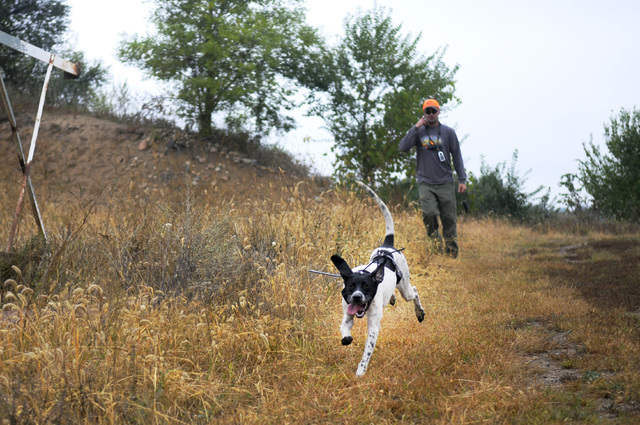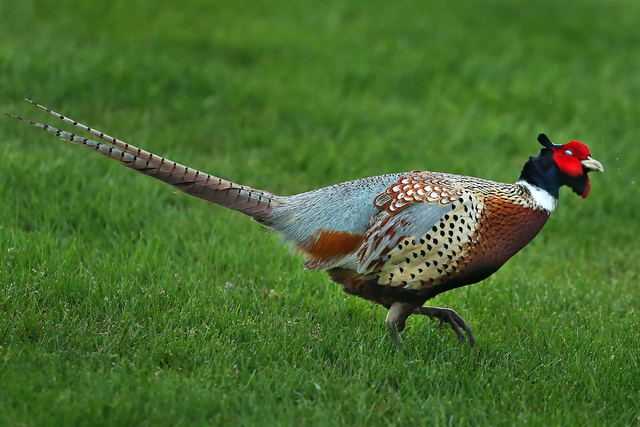Hunting dogs need training to keep from running amok


More years ago than I care to remember, my brother-in-law and I were hunting pheasants with a friend on a small farm in central Utah. We spaced ourselves about 30 yards or so apart and began walking parallel to each other as we followed Bear through a field planted in some kind of grain.
Bear worked back and forth with his nose to the ground one minute and pointed toward the sky the next. He wasn’t the prettiest dog as golden retrievers go, but if there was a pheasant in that field, Bear would sniff him out. Just watching Bear at work was worth the sleep lost during hunting season.
Suddenly, Bear put his head down tight to the ground and quickened his pace. When his tail started wagging, I knew he was on a bird. His wasn’t a true point, but there was no mistake, he was saying: “Hey, there is a bird in here, so get ready to do your job.”
As we prepared for the bird to flush, a German shorthaired pointer from two fields over showed up and went on to point next to Bear. Behind him came his hunter, yelling the dog’s name and cursing him at the same time. Obviously, Bear wasn’t too impressed with the shorthair’s trespass. Neither was I.
When bird hunting, dogs can be a blessing or a curse. They can bring a downed bird to hand or run amok and leave you hollering and cursing its birth. Not to mention ruining other hunters’ outdoor experience. Perhaps the biggest mistake hunters make is buying a pup and assuming it will automatically know what to do just because it comes from a hunting breed. They will hunt instinctively, but you want them to hunt for you, not for themselves.
Simply buying a pup with good breeding is not enough. The key to having a good dog is training, said Bob and Jeanette Smith, longtime dog trainers and members of the Las Vegas Hunting Retriever Club. Though the Smiths train their dogs for competitive dog trials, the principles for developing good trials dogs also apply to developing good hunting dogs.
Having a good dog starts with basic obedience training, said Jeannette, who also offered advice for ensuring the safety of a hunter and his dog:
“The hunter needs to be in total control of their dog at all times. That means they have to come when they are called. They don’t go after the bird until you release the dog, and you need to have the dog trained so that they pick up the bird and bring it and deliver it to hand.”
Dog owners have three choices in training their canine pal for hunting. One, do nothing and suffer the consequences in the field. Two, train the dog themselves. And three, send the dog to school. Scratch that first option right now because you won’t like the result.
If you choose to train the dog yourself, you can find help at regular gatherings of the LVHRC. After summer temperatures begin to cool, club members gather once a month to work on some aspect of dog training.
“A lot of the dogs we see at these sessions are beginning dogs,” Bob Smith said. “Either Jeanette or myself, or someone else in the club with experience, will be working with them one-on-one, and just trying to give that person a picture of what they need to be able to do in order to have a well-trained dog. Of course, that goes back to obedience.”
Retrievers will all go after a downed bird. The question is will they bring it back after they get it? That is where training comes in.
If you would rather have your dog trained by someone else, you can send them to a professional trainer. This is similar to sending your dog to boarding school because they generally go and live at the trainer’s facility, but it isn’t cheap. The results, however, can be quite good. It depends on the depth of your pocket book.
Freelance writer Doug Nielsen is a conservation educator for the Nevada Department of Wildlife. His “In the Outdoors” column, published Thursday in the Las Vegas Review-Journal, is not affiliated with or endorsed by NDOW. Any opinions he states in his column are his own. He can be reached at intheoutdoorslv@gmail.com.












